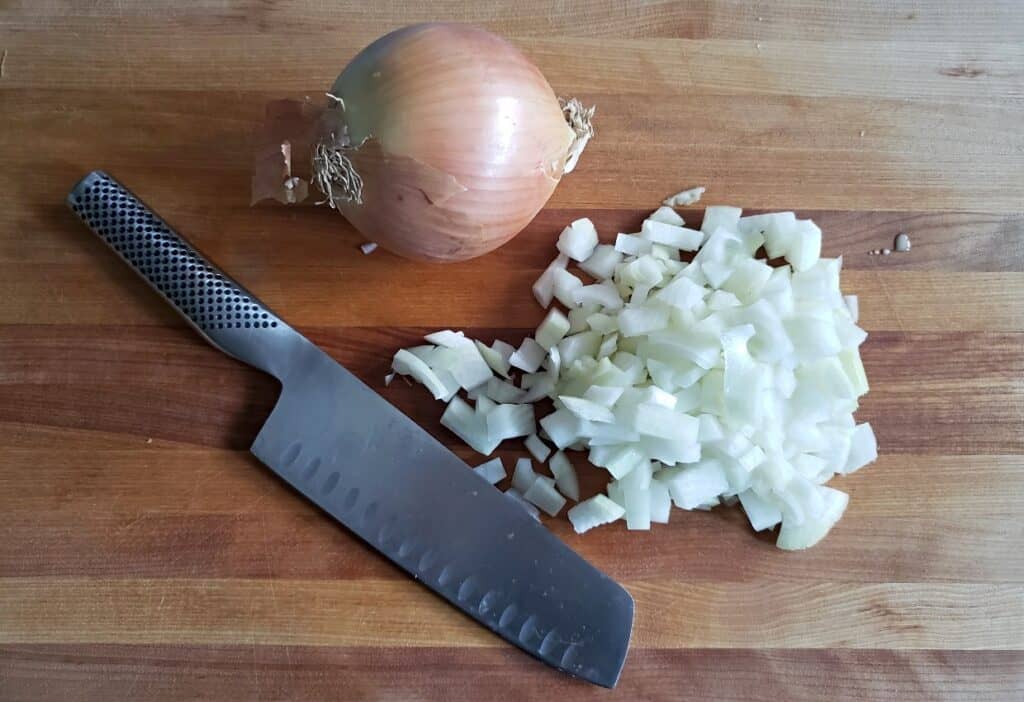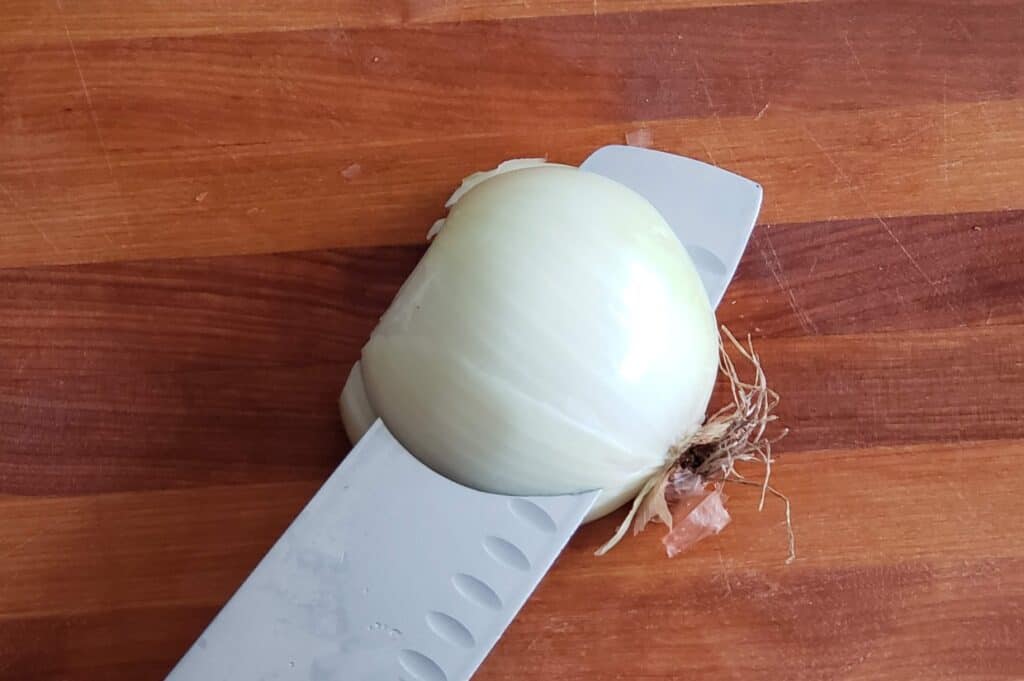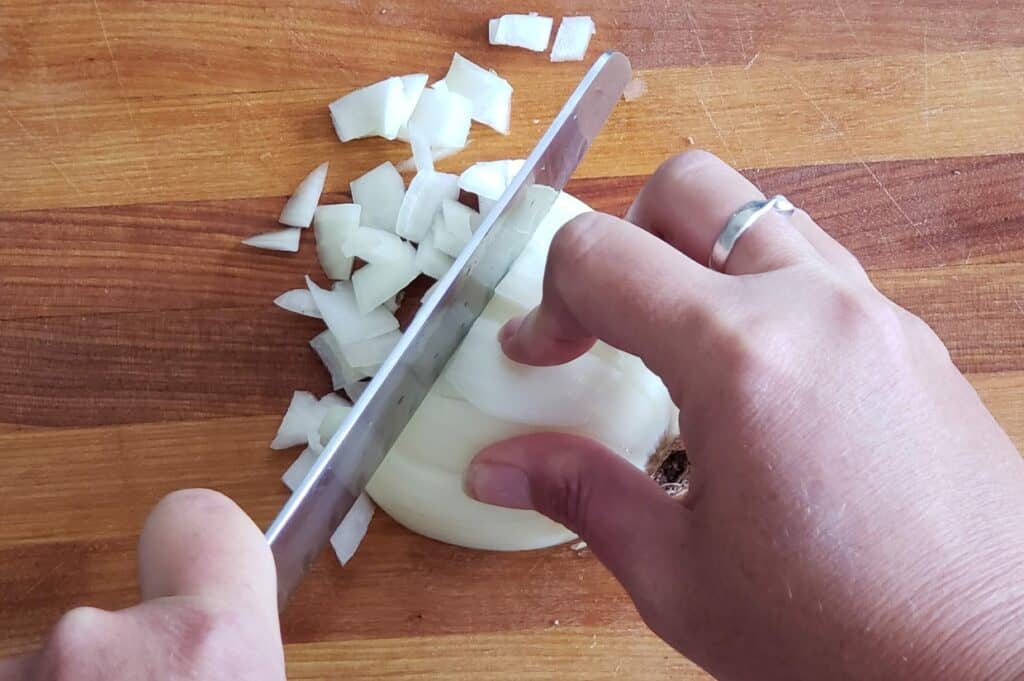Wipe away your tears, both figuratively and literally. When you learn how to cut an onion, you’ll be shocked to see how quickly and easily you can do it. With tips to keep you from crying when you cut an onion to the easy steps to quickly and safely chop or slice it, you’ll be an onion pro in no time.

Why do onions make you cry?
Onions make you cry because of a chemical called syn-propanethial-S-oxide. As you cut an onion, you break open the plant cells that release enzymes and sulfenic acid that combine to create the chemical.
This chemical is a gas that is volatile, meaning it easily vaporizes. When it comes into contact with your eyes, it irritates the cells in your eyes, causing them to release tears.
How can you cut onions without crying?
You can do a few things to reduce the tears you cry when you cut onions. Some lucky people aren’t bothered by the chemical compound at all, but if you aren’t one of those lucky people, try these tips.
A barrier between your eyes and the syn-propanethial-S-oxide will keep you from crying.
“I always find that keeping my contact lenses in stops me from crying, if I don’t have them in then I wear swimming goggles, this isolates my eyes and stops me from crying.”
— Mandy Applegate, Splash of Taste
Regular glasses can also help, as can a face shield. Be careful not to rub or touch your eyes when you cut onions, especially if you wear contacts, as the compound gets on your fingers as soon as you make that first cut. The chemical will irritate your eyes even more if it comes into direct contact with them.
If you cut the onion under running water, the chemical compound washes away. However, this can make for a slippery surface and is not the safest way to cut a vegetable.
Placing a wet paper towel near the onion also works well.
Filled with appetizers, salads, sides, mains and desserts, Food Drink Life's cookbook will become your favorite!
- Easy and delicious recipes from a variety of top chefs and recipe developers.
- Bright, colorful pictures on every page.
- Printer-friendly recipes that you can download instantly to your device.
- Printable shopping list and a kitchen conversion sheet.
You can also place the onion in the freezer for a few minutes before cutting it. This slows the release of the compounds, but be sure to not leave it in longer than about five minutes. Truly freezing your onion will burst the plant cells and give you a soggy onion.
Try running a fan or turn on your oven vent to help disperse the compounds.
What kind of knife should you use to cut onions?
Choosing the right knife ensures you can quickly and easily chop your onion. More importantly, it helps ensure you do so safely.
Select a sharp knife. While this may feel counterintuitive, a sharp knife is safer than a dull knife. The sharp knife cuts through the onion more easily, so you use less force and are less likely to have the knife swerve or cut through the onion suddenly and injure yourself.
You also want to use an 8- or 10-inch chef’s knife. The right size knife helps ensure you have the control you need to not cut yourself accidentally. Skip the paring knife.
How to chop an onion
While it can seem intimidating to chop an onion, these five simple steps will get you a neatly chopped or diced onion in under a minute once you practice. It’s easy as one-two-three once you have this strategy down pat.
When you chop your onion, start by slicing off the stem end as close to the top as you can. This is the end that isn’t “hairy” where the roots are still attached.
Place the onion cut side down for stability, and slice straight through the hairy root end to cut the onion in half with the root end still holding each half together.
Use your fingers to peel back the dried skin of the onion and remove it. Yes, the hairy end stays in place.
Place the long cut end on your cutting board, and use your knife to carefully cut three horizontal cuts through the onion from the stem end to the root, but be sure to leave the root end intact.

Think of it like cutting “smiley faces” into the onion. You want them evenly spaced, and yes, no matter how large or small your onion is, you only need to make three cuts.
Pro tip: Always create a flat edge when you slice anything, from a potato to a carrot to an eggplant. The flat end always sits on the cutting board to keep whatever you cut from rolling or sliding. This is a much safer way to cut anything.
Next, make three slices from the root of your onion to the stem end across the top again being sure to not cut through the root end.

Finally, cut through the onion from the stem end to the root end, which creates the onion pieces you need. The closer you make these final cuts, the smaller your onion pieces turn out.

That’s it. It’s truly that easy to chop or dice an onion.
What is the difference between a chopped onion versus a diced onion?
The difference between a chopped and diced onion is purely the size of the pieces you have at the end. Chopped onions are larger chunks, while diced onions are smaller pieces.
Chopped onions are common in recipes where the onion gets cooked with other ingredients large ingredients, like soups and stews where the onion needs to hold together with other ingredients. You want a smaller dice for recipes like Sloppy Joes or homemade baked beans.
When a recipe asks for chopped onion, the pieces are about a half inch in size, so make that final cut about a half inch or slightly further apart on the onion.
Diced onions are smaller, and typically closer to one-quarter inch in size. To dice an onion, just create that final cut closer together as you slice across the onion.
If you end up with pieces that are too big, throw away the root end, and place your onion pieces in a pile. Run your knife through the pile from one side to the other, using a rocking motion to cut the onion further.
How to slice an onion
Of course, some recipes require a different style of onion pieces. If you make crockpot garlic pork, you need half-moon slices of onion. Fried onion rings and hamburgers need rings. Both are quick and easy to make.
In fact, slicing an onion is even faster than chopping or dicing it since you don’t need to make as many directional cuts into the onion.
For the half moons, start cutting the onion like you’re going to chop it through the peeling step. When you place it cut-side down on the cutting board, slice through it from the top starting at the stem and going to the root end.
To make rings, cut off the stem end, then make a very thin cut into the tip of the onion to give yourself access to the skin to peel it back. Remove the skin, but keep the rest of the onion intact.
This is the only exception to putting a flat end on your surface. Instead, hold the onion on its side, and carefully use your sharp knife to cut from the stem end to the root end.
In both cases, you can make your slices as thick or as thin as you need, depending on the recipe. For example, you want thin rings for French onion soup but thicker rings for the aforementioned onion rings.
You’re ready to cut onions like a pro
The next time you have a recipe that calls for an onion, no matter what shape or size you need to cut it, you have the tools you need to do it well and to do it quickly.
Utilize these tips to ensure you don’t cry when you cut the onion, and then follow the steps to have your onion sliced, chopped or diced in under a minute.
Michelle Price is a food and travel writer at Honest and Truly who almost has an empty nest. She loves to provide both the inspiration and the confidence you need to help get you into the kitchen and on the road to enjoy new flavors and experiences.
